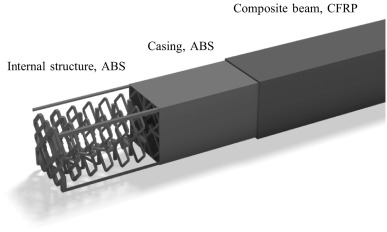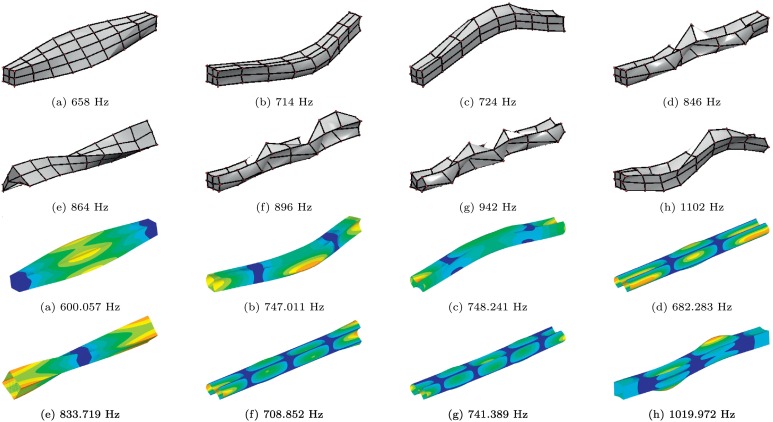In ‘Designing modular 3D printed reinforcement of wound composite hollow beams with semidefinite programming,’ researchers from the Czech Republic improve on composites used to make lattices for bioprinting. Their goal is to create a new and fully automated process for creating structural composites with both thin walls and hollow beams in structures. Ultimately, what they required was a basic optimization of a beam cross-section shape with an outer shape already set.
This type of research is not exactly new; in fact, in recent decades numerous structural optimization problems have been semidefinite programs. Here, the team considered ‘an industrial problem of designing the least-weight internal structure of a thin-walled filament-wound composite machine tool component prone to shear and buckling wall instabilities.’
Beam laminate was created for the load of dynamic loads, with wall instabilities defined regarding free-vibrations eigenfrequencies. The weaknesses were reduced here with a foam core structure inserted into the beam; however, it was found to be cost-prohibitive and labor intensive to do so:
“Conversely, we have aimed to automatically design a structurally-efficient internal structure which can easily be manufactured using conventional low-cost 3D printers,” stated the researchers.
They also ‘extended’ the linear semidefinite programming to create globally-optimal least-weight lattice-like internal structures.
Greater rigidity was enabled in creating a prototype with a more lightweight internal structure created with a more efficient ‘convex linear semidefinite programming formulation.’ This allowed for basic free-vibration frequency elevated above a specific level, while still avoiding typical differentiability in multiple eigenvalues. The basic structure for the sample here was a ‘prismatic, laminated composite beam, measuring 1000 mm long, with an 80 × 80 mm thin-walled cross-section 2.2 mm thick.

Case study setup. (a) Outer dimensions and simply supported boundary conditions, (b) prismatic cross-section, and (c) compression molding load case.
The researchers noted that they had to be cautious upon creating a rigid connection between the internal structure and carbon composite. After creating a successful prototype, the team put it through the paces, beginning with the roving hammer test. There, they discovered ‘good agreement with model predictions’ in terms of bending, torsional, and shear eigenmodes.

The entire structure of considered composite beam design: internal structure (used for the reduction of wall instabilities and for increase of the lowest free-vibration frequency); casing of the internal beam structure (to allow for winding the final composite layer); composite layers, which transmit working load applied to the beam.
“The optimization output of the non-uniformly distributed lattice-like internal structure was further automatically post-processed and converted into a solid model ready for support-less additive manufacturing.”
“Improving the structural response with a material more than two orders of magnitude more compliant when compared to CFRP suggests concentrating on substituting ABS with high-stiffness continuous carbon fiber in future studies,” concluded the researchers. “Another essential future enhancement resides in accelerating the optimization algorithm by exploiting the range-space sparsity associated with the segment-based internal-structure decomposition.”

Selected experimentally determined natural frequencies and mode shapes, (a)–(h) top, and finite element model predictions of eigenmodes and eigenfrequencies, (a)–(h) bottom.
Researchers today are extremely interested how the creation of composites can improve 3D printing processes, mainly in strengthening materials, from the use of glass composites, to copper metal composites, to wire polymer, and so much more.
What do you think of this news? Let us know your thoughts! Join the discussion of this and other 3D printing topics at 3DPrintBoard.com.
[Source / Images: ‘Designing modular 3D printed reinforcement of wound composite hollow beams with semidefinite programming’]
Subscribe to Our Email Newsletter
Stay up-to-date on all the latest news from the 3D printing industry and receive information and offers from third party vendors.
You May Also Like
3D Printing Unpeeled: New Arkema Material for HP, Saddle and Macro MEMS
A new Arkema material for MJF is said to reduce costs per part by up to 25% and have an 85% reusability ratio. HP 3D HR PA 12 S has been...
3D Printing News Briefs, January 20, 2024: FDM, LPBF, Underwater 3D Printer, Racing, & More
We’re starting off with a process certification in today’s 3D Printing News Briefs, and then moving on to research about solute trapping, laser powder bed fusion, and then moving on...
3D Printing Webinar and Event Roundup: December 3, 2023
We’ve got plenty of events and webinars coming up for you this week! Quickparts is having a Manufacturing Roadshow, America Makes is holding a Member Town Hall, Stratafest makes two...
Formnext 2023 Day Three: Slam Dunk
I’m high—high on trade show. I’ve met numerous new faces and reconnected with old friends, creating an absolutely wonderful atmosphere. The excitement is palpable over several emerging developments. The high...































